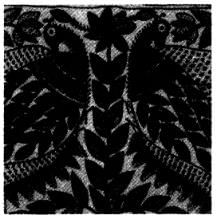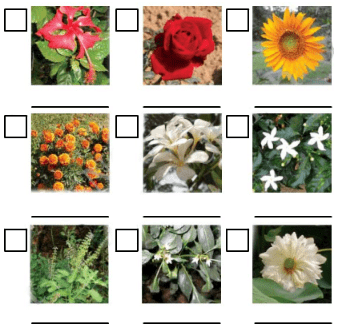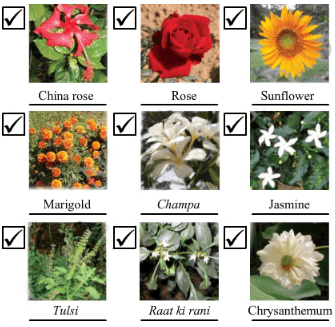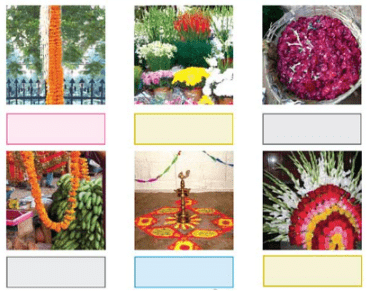NCERT Solutions for Class 4 EVS Chapter 11 - The Valley Of Flowers
Page No 84
Ques 1: Have you ever seen so many flowers grow together anywhere? where?
Ans: Yes, I saw so many flowers growing together. I saw them in the garden of my school.
Disclaimer:
The purpose of this section is to encourage the students to observe their surroundings. The answer may vary according to the students’ observations and experiences. It is highly recommended that the students prepare the answer on their own.
Ques 2: How many differently coloured flowers have you seen?
Ans: I have seen flowers of several colours.
Disclaimer: The purpose of this section is to encourage the students to observe their surroundings. The answer may vary according to the students’ observations and experiences. It is highly recommended that the students prepare the answer on their own.
Ques 3: Write their colours.
______________ ______________ ______________ ______________ ______________ ______________
Ans: They are red, yellow, black, blue, pink, white
Disclaimer: The purpose of this section is to encourage the students to observe their surroundings. The answer may vary according to the students’ observations and experiences. It is highly recommended that the students prepare the answer on their own.
Page No 85
Ques 1: Now you were just left counting, weren’t you?
Ans: Yes, but it is not possible to count the flowers in a garden as they are countless.
Disclaimer:
The purpose of this section is to encourage the students to observe their surroundings and be interactive. The answer may vary according to the students’ observations and experiences. It is highly recommended that the students prepare the answer on their own.
Ques 2: Look at the designs made by your friends as well.
Ans: Disclaimer:
Disclaimer:
The purpose of this section is to encourage the students to observe their surroundings and interact with others. The answer may vary according to the students’ observations and experiences. It is highly recommended that the students prepare the answer on their own.
Page No 86
Ques 1: Here are some pictures of flowers. Mark a (✔) on the flowers which you recognise. Write their names too if you know.
Ans:
Ques 2: From the pictures given above, and other flowers that you know, give names of two which
• grow on trees _______ _______
• grow on bushes _______ _______
• grow on creepers _______ ________
• grow on water plants______ ______
• bloom only at night _______ _______
• bloom in the day and close at night ______ ______
Answer:
| • grow on trees | Gulmohar | Palash |
| • grow on bushes | Oleander | Lavender |
| • grow on creepers | Coral vine | Trumpet vine |
| • grow on water plants | Lotus | Water lily |
| • bloom only at night | Moon flower | Queen of Night |
| • bloom in the day and close at night | Morning glory | Poppy |
Page No 87
Ques 1: Which flowers can you recognise by their scent, even with your eyes closed?
Ans: Rose, and jasmine can be recognised by their scent, even with our eyes closed.
Ques 2: Which flowers bloom all the year round?
Ans: Sadabahar and rose
Ques 3: Which flowers bloom only in certain months?
Ans: Flowers such as rajnigandha usually blooms from April to September.
Disclaimer : This is a sample answer. There can be other flowers that bloom in certain months.
Ques 4:
(i) Have you ever seen a board like this put up anywhere?
(ii) Do people pluck flowers even when this board is there?
(iii) Why do you think they do this?
(iv) Should they do this?
(v) What would happen if everybody plucked flowers?
Ans:
(i) Yes, such kind of boards are often seen in parks and gardens.
(ii) Yes, some people pluck flowers even when such a board is present.
(iii) They do this because they do not respect the rules and think that plucking a flower does not cause any harm to the place. They may even do this for fun.
(iv) No, people should not pluck flowers.
(v) If everybody starts plucking flowers, then there would be no flowers in the gardens and the parks. Without flowers, there would be no beauty and no colours in such places. Also, new flower plants would not grow.
Page No 88
Children who can bring flowers may bring one or two flowers to class. Remember that you must collect only fallen flowers. Do not pluck any flower. Make groups of three or four children and look at one flower carefully –
Ques 1: What is the colour of the flower?
Ans: Red
Ques 2: What kind of a scent does it have?
Ans: It has a lovely scent.
Ques 3: What does it look like – a bell, a bowl, a brush or anything else?
Ans: It has a bowl shape.
Ques 4: Do these flowers grow in bunches?
Ans: No, usually they do not grow in bunches.
Ques 5: How many petals does it have?
Ans: About 40 to 100
Ques 6: Are all the petals joined together or separate?
Ans: Petals are separate.
Ques 7: Outside the petals, can you see any green leafy structure? How many are there?
Ans: Yes. They are four.
Ques 8: Inside the petals, in the middle of the flower, can you see some thin structures? Write its colour.
Ans: Yes, The colour of this structure is pink-red.
Ques 9: When you touch these, do you find a powdery thing on your hands?
Ans: Yes
Disclaimer: The purpose of this section is to encourage the students to observe their surroundings. The answer may vary according to the students’ observations and experiences. It is highly recommended that the students prepare the answer on their own.
Page No 89
Ques 1: What differences do you find between a flower and a bud?
Ans: A small part that grows on a plant and develops into a flower is called a bud. A flower, developed from a bud, is the reproductive structure of a plant. Buds actually form the very early phase of flower formation.
Ques 2: Draw the picture of a bud and its flower in your notebook.
Ans:
Disclaimer: The purpose of this section is to encourage the students to show their imaginative and creative skills. The answer may vary according to the students’ observations and experiences. It is highly recommended that the students prepare the answer on their own.
Ques 3: Can you tell how many days will a bud take to bloom into a flower? Let us try and find out.
(a) Choose a bud that is growing on a plant and look at it everyday. Write the name of the plant.
Ans: It takes about 4 to 5 days. This was a rose plant.
(b) When you first saw this bud, the date was _________. Now when the bud has bloomed into a flower, the date is _______. How many days did the bud take to become a flower?
Ans: When I first saw this bud, the date was 1st February Now when the bud has bloomed into a flower, the date is 5th February.
(c) Ask your friends the names of the different flowers that they have seen. How much time did it take their buds to become flowers?
Ans: China rose takes about seven days. Sunflower takes about seven to eight days.
(d) Also observe how many days the same flower took to dry.
Ans: Sunflower takes about 30 to 40 days to become dry and Chine Rose takes about 30 days to become dry.
Disclaimer: The purpose of this section is to encourage the students to observe their surroundings and interact with others. The answer may vary according to the students’ observations and experiences. It is highly recommended that the students prepare the answer on their own.
Page No 90
Ques 1: Find out names of any two flowers which are used for making medicines?
Ans: Two flowers that are used for medicinal purposes are rose and hibiscus.
Disclaimer: This is a sample answer. The answer may vary according to the students’ observations and experiences.
Ques 2: How is rose water used in your house? Is it used as medicine, sweets, lassi or something else? Find out and tell others.
Ans: Rose water is used as medicine for the eyes and the skin. It is also used for making gulkand, which is a sweet. It can also be used in cosmetics, perfumes, garlands, etc.
Disclaimer: This is a sample answer. The answer may vary according to the students’ observations and experiences.
Page No 91
Ques 1: Find out and write the names of some more flowers that are used for making colours.
Ans: Rose and China Rose are used to make colours.
Disclaimer: The purpose of this section is to encourage the students to observe their surroundings. The answer may vary according to the students’ observations and experiences. It is highly recommended that the students prepare the answer on their own.
Ques 2: Can you think of a colour of which there is no flower?
Ans: I think there are no flowers which have silver and grey colour .
Disclaimer: The purpose of this section is to encourage the thinking abilities of the students. The answer may vary according to the students’ observations and experiences. It is highly recommended that the students prepare the answer on their own.
Ques 3: Write the names of such flowers which are used to make scents.
Ans: Rose, jasmine and many other flowers are used to make scents.
Disclaimer: The purpose of this section is to encourage the students to observe their surroundings and interact with others. The answer may vary according to the students’ observations. It is highly recommended that the students prepare the answer on their own.
Page No 92
Talk about it
Ques 1: Do you know when such songs are sung?
Ans: Such songs are sung on the occasions of marriage
Disclaimer: The purpose of this section is to encourage the students to observe their surroundings and interact with others. The answer may vary according to the students’ observations and experiences. It is highly recommended that the students prepare the answer on their own
Ques 2: Do you or anybody else at home know other such songs? Collect songs, poems, etc., on flowers. Write them down and put them up in the classroom.
Ans: My sister, aunty and mother know several such songs.
Disclaimer: The purpose of this section is to encourage the students to observe their surroundings and interact with others. The answer may vary according to the students’ observations and experiences. It is highly recommended that the students prepare the answer on their own.
Ques 3: Are any special flowers used on certain occasions by your elders? Make a list of different occasions and the flowers used at each.
| Occasion | Name of flower |
Ans:
| Occasion | Name of flower |
| Lakshmi Puja | Lotus |
| Bihu | Kopou |
| Friendship Day | Yellow roses |
Disclaimer: The purpose of this section is to encourage the students to observe their surroundings and interact with others. The answer may vary according to the students’ observations and experiences. It is highly recommended that the students prepare the answer on their own.
Page No 93
Let us know some more
Have you ever seen anyone selling flowers anywhere? If there are any flower-sellers nearby ask them these questions and write –
Ques 1: What are the different flowers that they sell? Ask them the names of three flowers.
Ans: They sell rose, jasmine and dahlia.
Disclaimer: The purpose of this section is to encourage the students to observe their surroundings and interact with others. The answer may vary according to the students’ observations and experiences. It is highly recommended that the students prepare the answer on their own.
Ques 2: Where do they bring these flowers from?
Ans: They bring these flowers from gardens and horticulture farms.
Disclaimer: The purpose of this section is to encourage the students to observe their surroundings and interact with others. The answer may vary according to the students’ observations and experiences. It is highly recommended that the students prepare the answer on their own.
Ques 3:Why do people buy flowers?
Ans: People buy flowers for various purposes. They use these flowers for worshipping Gods, for decoration, for giving as gift to others and for medicinal or cosmetic purposes.
Ques 4: In what forms do flower-sellers sell their flowers? Look at these picture. Tick against those forms that you have seen.
Any other form that you have seen –
Ans: Sellers sell flower in the form of Gajra
Disclaimer: The purpose of this section is to encourage the students to observe and interact actively with their surroundings. The answer may vary according to the students’ observations and experiences. It is highly recommended that the students prepare the answer on their own.
Page No 94
Ques 1: Find out the prices of these different forms.
One garland _________
One strand __________
One flower __________
Ans:
One garland - 50/- Rs.
One strand - 20/- Rs.
One flower - 5/- Rs.
Ques 2: Has the flower-seller learnt to make bouquets or a net of flowers from anybody? From whom?
Ans: Generally they learn to make bouquets or garland of flowers from their elders.
Ques 3: Would they like the other members of their family to do this work? Why?
Ans: Yes, they would like the other members of their family to do this work because this work also provides good income.
Disclaimer: The purpose of this section is to encourage the students to observe their surroundings and interact with others. The answer may vary according to the students’ observations and experiences. It is highly recommended that the students prepare the answer on their own.
|
53 videos|217 docs|54 tests
|
FAQs on NCERT Solutions for Class 4 EVS Chapter 11 - The Valley Of Flowers
| 1. What is the significance of the Valley of Flowers? |  |
| 2. How to reach the Valley of Flowers? |  |
| 3. What is the best time to visit the Valley of Flowers? |  |
| 4. Is there any accommodation available in the Valley of Flowers? |  |
| 5. Are there any restrictions or permits required to visit the Valley of Flowers? |  |



















